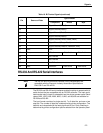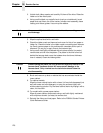
The Negotiation Phase
269
The Negotiation Phase
The negotiation phase determines which operating mode will be used. At this
time, the host and the printer will sense what devices are attached, the
supported signals available, and which mode to use. The selected mode, in
turn, defines the pins on the Bi-Tronics interface connector.
There are 36 pins on the parallel interface. Each one sends a different signal.
Pin 1, for example, can send a Strobe signal or a HostClk signal, depending
on the mode selected. Table 19 shows the different definitions.
Signals
Bi-Tronics interface signals between the host and the printer are defined
below.
Host Clock / nWrite. Driven by the host. Data is transferred from host to
printer. When the printer sends data, two types are available. In Nibble mode,
the signal is set high. In Byte mode, the signal is set low.
Data 1 through Data 8. These pins are host-driven in Compatibility mode and
bidirectional in Byte mode. They are not used in Nibble mode. Data 1 is the
least significant bit; Data 8 is the most significant bit.
Printer Clock / Peripheral Clock / Interrupt. Driven by the printer. A signal
from the printer indicating the character or function code has been received
and the printer is ready for the next data transfer.
Printer Busy / Peripheral Acknowledge / nWait. Driven by the printer.
Indicates the printer cannot receive data. (Data bits 4 and 8 in Nibble Mode.)
Acknowledge Data Request / nAcknowledge Reverse. Driven by the
printer. Indicates the printer is in a fault condition. (Data bits 3 and 7 in Nibble
mode.)
Xflag. Driven by the printer. A high true level indicating the printer is ready for
data transfer and the printer is online. (Data bits 2 and 6 in Nibble mode.)
Host Busy / Host Acknowledge / NDStrobe. Driven by the host. Activates
auto-line feed mode.
Peripheral Logic High. Driven by the printer. When set high, the printer
indicates all of its signals are in a valid state. When set low, the printer
indicates its power is off or its signals are in an invalid state.
nReverse Request. Driven by the host. Resets the interface and forces a
return to Compatibility mode idle phase.
nData Available / nPeripheral Request. Driven by the printer. Indicates the
printer has encountered an error. (Data bits 1 and 5 in Nibble mode.)
1284 Active / nAStrobe. Driven by the host. A peripheral device is selected.
Host Logic High. Driven by the host. When set to high, the host indicates all
of its signals are in a valid state. When set to low, the host indicates its power
is off or its signals are in an invalid state.
nInit. Resets init interface from the host.


















